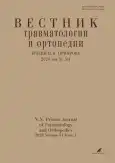Evaluation of the quality of life in patients with meningiomas of the craniovertebral junction using a developed questionnaire in a neurosurgical clinic
- Authors: Shimanskiy V.N.1, Sultanov R.A.1, Yusupova D.G.2, Poshataev V.K.1, Zimin A.A.2, Tanyashin S.V.1, Zaytsev A.B.3, Karnaukhov V.V.1,4, Suponeva N.A.2
-
Affiliations:
- Burdenko Neurosurgical Center
- Neurology Research Center
- Sechenov First Moscow State Medical University
- Pirogov Russian National Research Medical University
- Issue: Vol 31, No 1 (2024)
- Pages: 21-30
- Section: Original study articles
- URL: https://journal-vniispk.ru/0869-8678/article/view/260221
- DOI: https://doi.org/10.17816/vto608174
- ID: 260221
Cite item
Full Text
Abstract
BACKGROUND: A validated tool for assessing the quality of life specific to a particular disease has not yet been developed. Previous studies only partially investigated the quality of life of patients with craniovertebral junction meningiomas and did not include the entire spectrum of functional disorders in this disease.
AIM: To develop and validate a questionnaire to assess the quality of life of patients with craniovertebral junction meningiomas.
MATERIALS AND METHODS: A retrospective and prospective study of 119 patients with craniovertebral junction meningiomas was conducted before and after surgical and combined (surgical removal of the tumor followed by radiation therapy) treatment using a validated questionnaire developed.
RESULTS: A quality of life questionnaire for patients with craniovertebral junction meningiomas was developed and validated. Determining the internal consistency of the scale showed that the Cronbach alpha coefficient was α=0.78 (p <0.001), confirming its sufficient level. In analyzing the sensitivity of the questionnaire, the estimates before and after surgery did not differ significantly (p=0.62, t-criterion).
CONCLUSIONS: This study developed the first quality of life questionnaire worldwide for patients with craniovertebral junction meningiomas. In summary, this questionnaire is not able to reflect the dynamics of the quality of life.
Full Text
##article.viewOnOriginalSite##About the authors
Vadim N. Shimanskiy
Burdenko Neurosurgical Center
Email: vadim@shimansky.ru
ORCID iD: 0000-0002-3816-847X
SPIN-code: 6970-6906
MD, Dr. Sci. (Med.), professor
Russian Federation, MoscowRuslan A. Sultanov
Burdenko Neurosurgical Center
Author for correspondence.
Email: rus4455@yandex.ru
ORCID iD: 0000-0003-1363-7564
SPIN-code: 6865-6586
MD, Cand. Sci. (Med.)
Russian Federation, MoscowDzhamilya G. Yusupova
Neurology Research Center
Email: dzhamilya-d@mail.ru
ORCID iD: 0000-0002-5826-9112
SPIN-code: 7532-8030
MD, Cand. Sci. (Med.)
Russian Federation, MoscowVladimir K. Poshataev
Burdenko Neurosurgical Center
Email: glaser@list.ru
ORCID iD: 0000-0002-3279-3733
SPIN-code: 5349-2639
MD, Dr. Sci. (Med.)
Russian Federation, MoscowAlexey A. Zimin
Neurology Research Center
Email: zimin.alexej82@gmail.com
ORCID iD: 0000-0002-9226-2870
SPIN-code: 9525-1805
MD, Cand. Sci. (Med.)
Russian Federation, MoscowSergey V. Tanyashin
Burdenko Neurosurgical Center
Email: STanyashin@nsi.ru
ORCID iD: 0000-0001-8351-5074
SPIN-code: 5490-1820
MD, Dr. Sci. (Med.)
Russian Federation, MoscowAlexandr B. Zaytsev
Sechenov First Moscow State Medical University
Email: zaytsev_a_b@staff.sechenov.ru
ORCID iD: 0000-0003-3774-3070
SPIN-code: 6791-7630
Cand. Sci. (Phil.)
Russian Federation, MoscowVasiliy V. Karnaukhov
Burdenko Neurosurgical Center; Pirogov Russian National Research Medical University
Email: VKarnayhov@nsi.ru
ORCID iD: 0000-0002-2581-8648
SPIN-code: 6112-2714
MD, Cand. Sci. (Med.)
Russian Federation, Moscow; MoscowNatalia A. Suponeva
Neurology Research Center
Email: suponeva@neurology.ru
ORCID iD: 0000-0003-3956-6362
SPIN-code: 3223-6006
MD, Dr. Sci. (Med.), professor, corresponding member of the Russian Academy of Sciences
Russian Federation, MoscowReferences
- Arnautovic KI, Al-Mefty O, Husain M. Ventral foramen magnum meningiomas. Neurosurgery. 2000;92 Suppl 1:71–80. doi: 10.3171/spi.2000.92.1.0071
- Fernandes MW, De Aguiar PH, Galafassi GZ, et al. Foramen magnum meningioma: Series of 20 cases. Complications, risk factors for relapse, and follow-up. Journal of Craniovertebral Junction and Spine. 2021;12(4):406–11. doi: 10.4103/jcvjs.jcvjs_58_21
- Paun L, Gondar R, Borrelli P, Meling TR. Foramen magnum meningiomas: a systematic review and meta-analysis. Neurosurgical Review. 2021;44(5):2583–2596. doi: 10.1007/s10143-021-01478-5
- Pirotte BJ, Brotchi J, DeWitte O. Management of anterolateral foramen magnum meningiomas: surgical vs conservative decision making. Neurosurgery. 2010;67 Suppl 3:58–70. doi: 10.1227/01.NEU.0000382971.63877.DD
- Samii M, Klekamp J, Carvalho G. Surgical Results for Meningiomas of the Craniocervical Junction. Neurosurgery. 1996;39(6):1086–1095. doi: 10.1097/00006123-199612000-00003
- Nassiri F, Price B, Shehab A, et al.; International Consortium on Meningiomas. Life after surgical resection of a meningioma: a prospective cross-sectional study evaluating health-related quality of life. Neuro-Oncology. 2019;21 Suppl 1:32–43. doi: 10.1093/neuonc/noy152
- Timmer M, Seibl-Leven M, Wittenstein K, et al. Long-Term Outcome and Health-Related Quality of Life of Elderly Patients After Meningioma Surgery. World Neurosurgery. 2019;125:697–710. doi: 10.1016/j.wneu.2019.01.158
- Wirsching HG, Morel C, Roth P, Weller M. Socioeconomic burden and quality of life in meningioma patients. Quality Life Research. 2020;29(7):1801–1808. doi: 10.1007/s11136-020-02461-1
- Shaffer BT, Cohen MS, Bigelow DC, Ruckenstein MJ. Validation of a disease-specific quality-of-life instrument for acoustic neuroma: the Penn Acoustic Neuroma Quality-of-Life Scale. Laryngoscope. 2010;120(8):1646–54. doi: 10.1002/lary.20988
- Ware JE Jr, Sherbourne CD. The MOS 36-item short-form health survey (SF-36). I. Conceptual framework and item selection. Medical Care. 1992;30(6):473–83.
- Raco A, Pesce A, Toccaceli G, et al. Quality of Life After Craniovertebral Junction Meningioma Resection: Shaping the Real Neurologic and Functional Expectancies About These Surgeries in a Contemporary Large Multicenter Experience. World Neurosurgery. 2018;110:583–591. doi: 10.1016/j.wneu.2017.05.177
- Karnofsky DA, Burchenal JH. The evaluation of chemotherapeutic agents against neoplastic disease. Cancer research. 1948;8:388–389.
- Escorpizo R, Stucki G, Cieza A, Davis K, Stumbo T, Riddle DL. Creating an interface between the International Classification of Functioning, Disability and Health and physical therapist practice. Physical Therapy. 2010;90(7):1053–63. doi: 10.2522/ptj.20090326
- In J, Kang H, Kim JH, et al. Tips for troublesome sample-size calculation. Korean Journal Anesthesiology. 2020;73(2):114–120. doi: 10.4097/kja.19497
- Keshwara SM, Gillespie CS, Mustafa MA, et al. Quality of life outcomes in incidental and operated meningiomas (QUALMS): a cross-sectional cohort study. Journal of Neuro-oncology. 2023;161(2):317–327. doi: 10.1007/s11060-022-04198-y
- Likert R. A technique for the measurement of attitudes. Archives of Psychology. 1932;22(140):5–55.
- Belova AN. Scales, tests and questionnaires in neurology and neurosurgery. Moscow: Practical Medicine; 2018. 696 р. (In Russ). EDN: LSYFLZ
- Mehta GU, Zenonos G, Patibandla MR, et al. Outcomes of stereotactic radiosurgery for foramen magnum meningiomas: an international multicenter study. Journal Neurosurgery. 2018;129(2):383–389. doi: 10.3171/2017.3.JNS163008
Supplementary files








